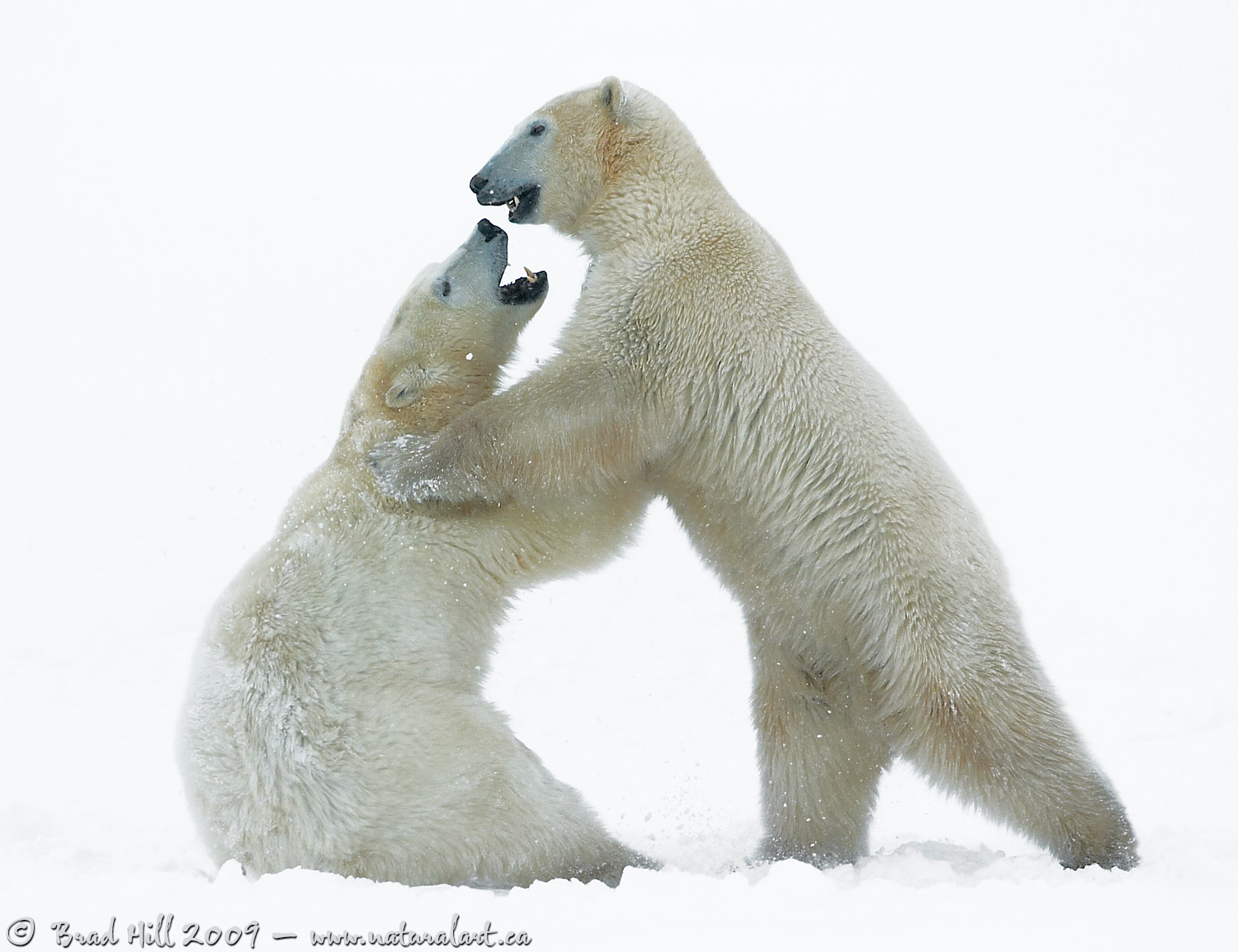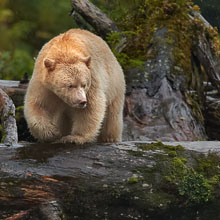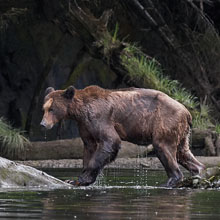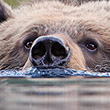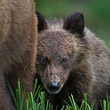Availability: Undetermined - Enquiries?
In the Field
Tundra Triangles. Cape Churchill, MB, Canada. October 24, 2004.
It's my experience that one of the most critical (and difficult) things to do in wildlife photography is to fall slightly out of awe (or love, I suppose) with the animals you are shooting and remember to treat them simply as photographic subjects. And of course, to remember that to portray ANY subject most effectively one has to apply basic compositional principles. For instance, when you're watching sparring polar bears, it's totally easy to get completely wound up in the action and, in some respects, relax your "photographer's eye". In this case, I had been freezing my butt off for a good twenty minutes (outside of the warmth of our tundra buggy) watching and photographing these bears sparring when I started to notice the interesting geometric patterns their bodies were forming while mock battling. Suddenly I had something "new" to watch for and, before long, the bears gave me - for a brief instant - this interesting series of triangles. Because I was watching for it and was ready to shoot, I managed to capture the instant. Interestingly, when I was reviewing my images on my laptop that evening, about half of my companions who were doing the "peeking-over-the-shoulder" thing instantly noticed the triangles and exclaimed "cool" (or something of the sort). Others who have seen this image over the years have often said they liked it, but didn't know why. When I show them similar images, but without the strong triangular shapes, they're usually less interested in them. Shapes, lines, and other compositional principles matter in ALL photography, regardless of the strength of subject matter. And this is true even if the viewer knows NOTHING about "composition" or why they like an image.
By the way - the background in this image is NOT "blown out" - I shot this in a blizzard and the background was absolutely featureless and very, very white!
ADDITIONAL NOTES:
1. This image - in all resolutions - is protected by copyright. I'm fine with personal uses of them (including use as desktop backgrounds or screensavers on your own computer), but unauthorized commercial use of the image is prohibited by law. Thanks in advance for respecting my copyright!
2. Like all wildlife images on this website, the subject(s) is/are fully wild and completely unconstrained. Besides the potential impact of my/our presence, nothing has been done to intentionally alter or affect the ongoing behavior of the subject and, of course, there has been no use of any form of bait or other form of wildlife attractants (including vocalizations or other sounds).
Behind the Camera
Tundra Triangles. Cape Churchill, MB, Canada. October 24, 2004.
Digital Capture; Compressed RAW (NEF) format; ISO 200.
Nikon D2H with Nikon 200-400 mm f/4G ED-IF AF-S VR lens @ 360 mm (540 mm effective focal length) supported on bean bag.
1/500s @ f5; +1.0 stop exposure compensation from matrix-metered exposure setting.
At the Computer
Tundra Triangles. Cape Churchill, MB, Canada. October 24, 2004.
RAW Conversion to 16-bit TIFF, including first-pass sharpening, using Phase One's C1 Pro.
All further digital correction using Adobe's Photoshop CS, including selective mid-tone contrast adjustment (using Photoshop's Shadow/Highlight tool), selective saturation enhancement, and selective sharpening for web output.
Conservation
Tundra Triangles. Cape Churchill, MB, Canada. October 24, 2004.
Ten percent of the revenue generated by this image will be donated to the Yellowstone to Yukon Conservation Initiative.
Species Status in Canada*: Special Concern (November 2002).
Polar Bears (Ursus maritimus) are the largest terrestrial carnivores on the planet and the most carnivorous of all bears. They are highly specialized and feed almost exclusively on Ringed Seals. Polar Bears hunt their prey from ice sheets and are dependent upon these ice sheets for their survival.
Like any highly-specialized organism, Polar Bears are highly susceptible to habitat alteration. Climate change - natural or human-induced - is probably the greatest long-term threat to Polar Bear survival. The longer ice-free seasons experienced in the southern reaches of their distribution is already making it difficult for them to hunt.
The Yellowstone to Yukon (Y2Y) Conservation Initiative seeks to ensure that the world-renowned wilderness, wildlife, native plants, and natural processes of the Yellowstone to Yukon region continue to function as an interconnected web of life, capable of supporting all of its natural and human communities, for current and future generations.
For more information on the status of Polar Bears in Canada, go to: http://www.speciesatrisk.gc.ca and search under "Polar Bears".
*as determined by COSEWIC: The Committee on the Status of Endangered Wildlife in Canada












